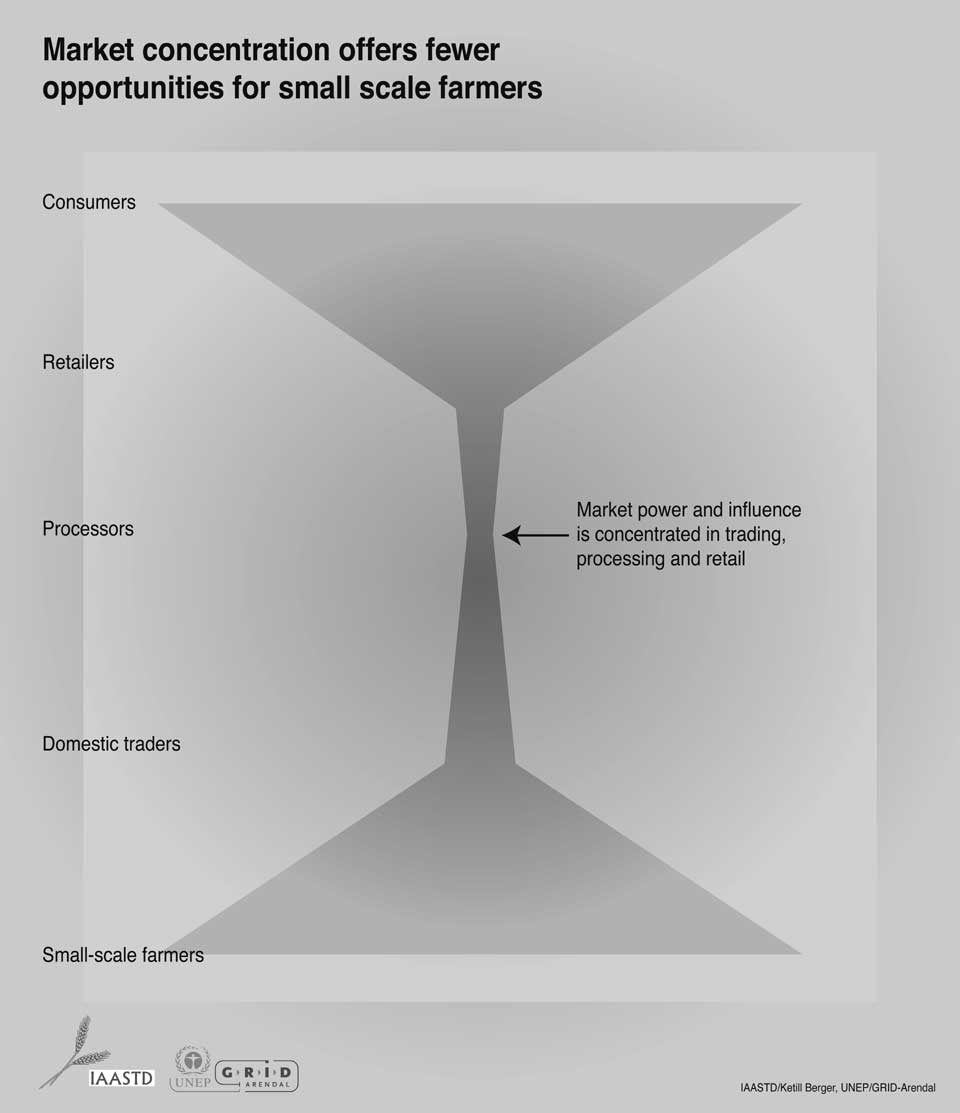lar commodities, such as Archer Daniel Midland, Unilever and Cargill.
This situation means that even when farmers organize and aggregate, produce quality goods, and sell collectively, they have insufficient volumes of sale to negotiate effectively with four to five giant corporations. There is increasing concern that lack of competition in the marketplace is having seriously negative social effects on agricultural producers; the most vulnerable are the poorly organized, resource poor farmers in developing nations (Figure 7-8).
One approach to address this imbalance in trade relationships is the establishment of international competition policy in the form of multilateral rules on restrictive business practices. A potential model for this approach is the French law (Loi Galland) that prohibits selling at a loss and "excessively low prices."
Another policy option that is widely noted is the reintroduction of price bands as a means of cushioning the impact of world price instability. For example Chile's Free Trade Agreements with EU and Canada allowed it to keep its agricultural price band which was designed to stabilize import costs of agricultural staples (including wheat, sugar, oil) through adjustment to tariffs on such with the objective of allowing a fair rate of return to Chilean farmers even if they were competing with heavily subsidized US farmers. In contrast the US-Chile Free Trade Agreement committed Chile to phase out its agricultural price band system. An international competition policy framework might also include creation of an independent UN agency to address some of the issues that UN Center for Transnational Corporations used to address.
7.2.7.3 Strategic impact assessment and comparative technology assessment
There is often a dearth of information on the potential social and economic benefits and risks of proposed trade agreements and emerging technologies alike. Policy tools to allow developing countries to better analyze benefits, risks and tradeoffs of proposed trade agreements and the introduction of new technologies are needed. Policy approaches to redress this issue include Strategic Impact Assessment (SIA) of trade agreements and Comparative Technology Assessment for emerging technologies. Additionally, increased research and more sensitive trade policy stimulations tailored to countries at different stages of development with different characteristics to their agricultural sectors may be helpful to inform policy choices to address development and sustainability goals (Morrison and Sarris, 2007).
SIAs have provided early warnings as well as research evidence that failing to mitigate negative environmental effects can substantially reduce net economic and welfare gains from trade. In this way, these assessments can provide critical information to governments and stakeholders allowing them to consider whether or not to reject or mitigate a trade policy proposal that is likely to worsen poverty, inequity or environmental degradation in certain sectors.
Strategic impact assessment of trade agreements that have been undertaken for regional agreements, such as NAFTA and multiple EU trade agreements, aim to give negotiators a fuller understanding of potential environmental impacts in their own countries, such that they may be taken

Figure 7-8.Agricultural market concentration.
into account alongside the economic and social considerations on which trade negotiations have traditionally been based. The fuller information on environmental issues enables negotiators to make more reliable tradeoffs, in those cases where the effects do not provide win-win outcomes for national and international economic, social and environmental concerns.
The European Commission for example has defined the goal of SIA as generating information to integrate sustainability into European trade policy by assessing a proposed trade agreement's potential impacts on sustainable development. SIAs, which are public documents, inform negotiators and interested stakeholders of the possible social, environmental, and economic consequences of a trade agreement; provide analysis that will help maximize benefits of the agreement through better management of environmental, social and economic resources; and inform the design of policy options, including capacity building and international regulation, that may maximize the benefits and reduce the negative impacts of the proposed trade agreement (George and Kirkpatrick, 2003).
Another noted policy option to increase information and transparency is the establishment of an intergovernmental framework for the comparative assessment of new technologies as they evolve from initial scientific discovery through to possible commercialization. For example, observers have noted that rapid developments in nanotechnologies and nano-material production may outcompete developing countries' primary commodities in international markets in the near and mid-term (ETC Group, 2005). All stakeholders, perhaps especially including developing